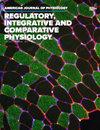患有和未患有 2 型糖尿病的中年至老年男性在运动强度和身体区域方面的出汗差异
IF 2.2
3区 医学
Q3 PHYSIOLOGY
American journal of physiology. Regulatory, integrative and comparative physiology
Pub Date : 2024-04-29
DOI:10.1152/ajpregu.00037.2024
引用次数: 0
摘要
2 型糖尿病与运动热应激时全身出汗减少有关。然而,目前还不清楚这种损伤是否与运动强度有关,也不清楚这种损伤是否均匀地发生在身体的各个部位。我们评估了患有 2 型糖尿病(T2D;年龄 59 (7) 岁;V.O2 峰值 32.3 (7.6) mL-kg-1-min-1;n=26;HbA1c 5.1-9.1%)和无糖尿病(对照组;61(5)岁;V.M.E.峰值 37.5(5.4) mL-kg-1-min-1; n=26) 在 40°C, ~17% 相对湿度下进行轻度(~40%V.M.O.peak)、中度(~50%V.M.O.peak)和剧烈(~65%V.M.O.peak)强度运动(分别以 ~150、200、250 W-m-2 的固定代谢产热引起)。与对照组相比,T2D组在中度和剧烈运动时的全身出汗量减少了约11%(T2D组与对照组的平均差异[95%置信区间]:-37 [-63, -12] g-m-2-h-1)和约13%(-50 [-76, -25] g-m-2-h-1)(p≤0.001),但轻度运动时的出汗量没有减少(-21 [-47, 4] g-m-2-h-1; p=0.128)。因此,相对于轻度运动,剧烈运动时与糖尿病相关的全身出汗率降低了2.3 [1.6, 3.1]倍(p<0.001)。此外,在剧烈运动时,这些与糖尿病相关的局部出汗障碍具有区域特异性(组别 × 区域交互作用:p=0.024),例如,与糖尿病相关的躯干(胸部、背部)局部出汗率降低是四肢(大腿、手臂)的 2.4 [1.2, 3.7] 倍。总之,在炎热、干燥的条件下进行评估时,与糖尿病相关的出汗障碍与运动强度有关,且躯干部位的出汗率高于四肢部位。本文章由计算机程序翻译,如有差异,请以英文原文为准。
Exercise intensity- and body region-specific differences in sweating in middle-aged-to-older men with and without type 2 diabetes
Type 2 diabetes is associated with reduced whole-body sweating during exercise-heat stress. However, it is unclear if this impairment is related to exercise intensity and whether it occurs uniformly across body regions. We evaluated whole-body (direct calorimetry) and local (ventilated-capsule technique; chest, back, forearm, thigh) sweat rates in physically active men with type 2 diabetes (T2D; aged 59 (7) years; V̇O2peak 32.3 (7.6) mL·kg-1·min-1; n=26; HbA1c 5.1-9.1%) and without diabetes (Control; aged 61 (5) years; V̇O2peak 37.5 (5.4) mL·kg-1·min-1; n=26) during light (~40%V̇O2peak), moderate (~50%V̇O2peak), and vigorous (~65%V̇O2peak) intensity exercise (elicited by fixing metabolic heat production at ~150, 200, 250 W·m-2, respectively) in 40°C, ~17% relative humidity. Whole-body sweating was ~11% (T2D-Control mean difference [95% confidence interval]: -37 [-63, -12] g·m-2·h-1) and ~13% (-50 [-76, -25] g·m-2·h-1) lower in the T2D compared to the Control group during moderate- and vigorous- (p≤0.001), but not light-intensity exercise (-21 [-47, 4] g·m-2·h-1; p=0.128). Consequently, the diabetes-related reductions in whole-body sweat rate were 2.3 [1.6, 3.1] times greater during vigorous relative to light exercise (p<0.001). Further, these diabetes-related impairments in local sweating were region-specific during vigorous-intensity exercise (group × region interaction: p=0.024), such that the diabetes-related reduction in local sweat rate at the trunk (chest, back) was 2.4 [1.2, 3.7] times greater than that at the limbs (thigh, arm). In summary, when assessed under hot, dry conditions, diabetes-related impairments in sweating are exercise intensity-dependent and greater at the trunk compared to the limbs.
求助全文
通过发布文献求助,成功后即可免费获取论文全文。
去求助
来源期刊
CiteScore
5.30
自引率
3.60%
发文量
145
审稿时长
2 months
期刊介绍:
The American Journal of Physiology-Regulatory, Integrative and Comparative Physiology publishes original investigations that illuminate normal or abnormal regulation and integration of physiological mechanisms at all levels of biological organization, ranging from molecules to humans, including clinical investigations. Major areas of emphasis include regulation in genetically modified animals; model organisms; development and tissue plasticity; neurohumoral control of circulation and hypertension; local control of circulation; cardiac and renal integration; thirst and volume, electrolyte homeostasis; glucose homeostasis and energy balance; appetite and obesity; inflammation and cytokines; integrative physiology of pregnancy-parturition-lactation; and thermoregulation and adaptations to exercise and environmental stress.

 求助内容:
求助内容: 应助结果提醒方式:
应助结果提醒方式:


